Welcome to Mazur's Coaches Corner
Over the next few weeks Darrell Mazur will share with us some strategies and tips which he has accquired over the last 20 years of playing Touch Football across Canada. For the first installment, The Coach will talk about Advanced Defenses.
Introduction
The Winnipeg Assassins Touch Football Team has represented Manitoba at the National Touch Bowl Championship from 1982 - 1993. During this period the team has consistently won tournaments and league Championships, while facing the top teams in the country. During these tournaments, the opposition has played a variety of different defences. Over the years the Assassins have borrowed, copied, and implemented various hybrids of these defences. In fact, now, the Assassins rarely play any conventional defence (i.e. 3-3, 4-2, 5-1) at all. The Assassins have developed defences called the "Box", the "Diamond" and have combined it with "Flips," and a "Monster."
However, the most successful defence is still man-to man. When the Assassins do not play man, they will often play a variety of combination defences, that is part man and part zone. The latest variation of this philosophy, is the Monster, or Rover. This defence compliments the athletic ability of the Monster.
The Assassins won the 1982 National Intermediate Championship and have been ranked in the top ten Nationally, in the Senior category, ever since. Recent accomplishments included winning the last two Football Canada National Touch Bowl Champion designation titles, in 2000, in Regina, and 2001 in Calgary.
Defensive Motion and Pre snap reads
Pre-Snap reads: This term refers to the Offence looking at the Defensive alignment before the ball is snapped.
The Assassins have learned that this really gives the advantage to the offence, and have determined that if by showing motion, i.e. moving from one positional alignment to another, prior to the snap, the pre-snap read is eliminated. As a result, the offence does not know what defence is being played.
Players can align with an outside shade in a six across alignment and then move to a 4-2 defensive look, or a 5-1 or man, all before the ball is snapped. With all this motion, it will be difficult to determine any accurate pre-snap read. Receivers will be trying to read what defence is being played as they run their routes.
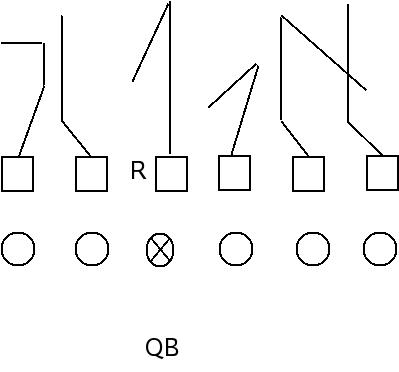
Flips
Another variation is having your defensive players switch assignments as the ball is snapped. The Flip (i.e. flipping or switching assignments) is called in the huddle, such as "Man, Flip on the corners." This means that the two "outer most" defenders will switch men, but align on their own men. See diagram. Flips can also occur with the two inside people as well. Flips can also occur when in zone.
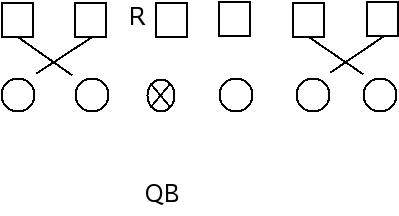
Man Flip on the Corner
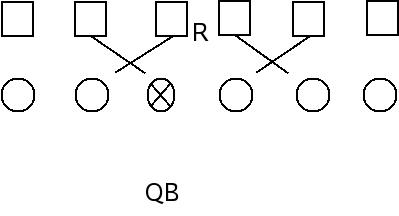
Man Flip Inside
Monster
The 3-2 Monster Defence evolved out of the strength of the different personnel we have. The defence features one man free, while the other defenders play a 3 - 2 zone (three men short, and two deep). The Monster can align wherever, as a rover or specifically, on a key receiver and double team him.
Although a variety of alignments are available, our defence uses the Monster, initially aligning in a regular set, showing false drops (false pre-snap reads) and then going to the area or man he thinks is going to get the ball. In this sense he is truly "free" to read and make the play.
However, against a star receiver, we would align him in the regular set, but would key him on that receiver. The benefit of this defence is that it allows your strong defenders a chance to anticipate the play, and aggressively attack the potential receiver. This occurs while the other defenders are dropping to their zones and all areas are accounted for. (Ideally this could be used on hooks, or slants, and have the "monster" sprint to the area/receiver, before or as the ball is thrown.)
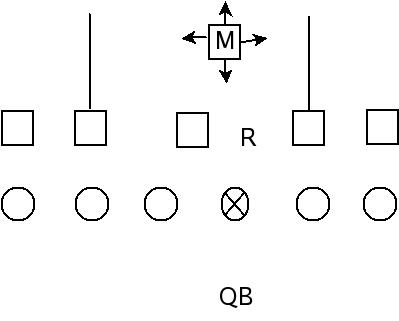
3-2 Monster
The Diamond
We first learned of this Defence from Eastern Canadian Teams. We played against a variety of defences, many times. Finally, after one tournament, when our play wasn't as effective as we thought it should have been, we asked the opposition, (Burlington Caesar's) how it was played. The following is what we learned about this defence:
It is based on the sound defensive principal of taking away the quick inside patterns, i.e. Hooks over the middle and any pattern over the short horizontal plain.
Strengths: - It gives a "man" look on the initial pre-snap read. The Quarterback's secondary read, (the safety) indicates a 5-1 zone read. (The typical "open area" deep sidelines-Fade route is taken away by the Corners). Imagine the confusion when the Quarterback sets up to throw the fade, and at the last second realizes the "man" coverage is now a zone coverage.

Responsibilities:
Corners - In the Diamond the corner plays "man" on the out, Jet/Fly, and Corner/Fly patterns. On any inside routes he releases his "man" to the inside short zone (covered by the 2nd and 3rd defenders, and the deep safety on Post routes. His man responsibility is strictly in the vertical plain, or his 1/4 of the field. The Corners must be aware of releasing their man to the inside and cannot be influenced too much by the "in" pattern. He must also pick up the slot, on the out and look for him on the Corner as well. The Corners first responsibility remains the W.R., therefore, he must first determine what area the W.R. is going to. The Corner must take the deep patterns away first and then, if not challenged, react to the short zone.
Safety - One of the remaining defenders, assumes the Deep Middle, or safety position, and picks up any deep route down the inside middle 1/3 or 2/4 of the field. The Defenders "drop" from any alignment.
Short Zone "People" - The three short defenders take away any "hot" or inside routes and pursue to any outside routes. Key the QB. look, and run like a rabbit. The short zonepeople must take the "hots" away initially.
Weaknesses: - Any outside pattern, to an inside receiver that results when the QB throws immediately, without a read. (A timing pattern.) i.e.
- Mirrored Corner Patterns would also cause the safety to "have to make a choice"

- Wide Receiver Clear, and slotback out, would challenge this defence, as the short zone people would have to chase from inside out.
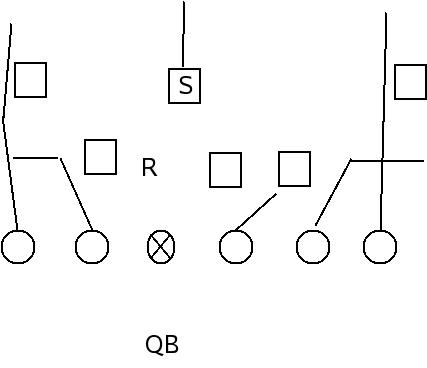
Summary:
The Diamond is used against more advanced teams. That is, Quarterbacks that read. ( It can be used against basic offensive teams and Quarterbacks, but if the Q.B. is not reading, his potential for confusion, is limited to his initial play call, thereby reducing the effectiveness of the Defence.)
Other combinations can be used. No defence is perfect. It should be remembered that as a defender, always know where your strengths are and what you are giving up! Prior knowledge of the opponent can give the defence an advantage, regarding knowing tendencies and who the "go to" guys are.
Conclusion
It is hoped that this chapter will provide you with some ideas, and alternatives to the basic defences commonly played in Touch Football. If they have, then it has served there purpose! Keep in Touch!!


